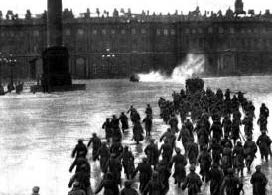The Party, The Masses and Communist Workers’ Power

Red Guards storm the Winter Palace, October 25, 1917
By fall 1917, most Bolsheviks (Communists) wanted “All power to the Soviets.” They wanted to overthrow the bosses’ Provisional Government and replace it with a government of soviets, councils representing workers, soldiers, sailors and peasants. When the second Congress of Soviets met late in October, it should become that revolutionary government.
The Communists had a lot of delegates in the soviets, especially in Moscow and Petrograd. But other parties there – some socialist — supported the imperialist war and wanted coalitions with capitalists. These policies made them traitors to the working class. How could such a Congress of Soviets end the war, feed the masses and help the peasants seize the land?
In the factories, the barracks and the working-class districts of major cities, local communist committees had mass support. Armed Red Guards from the factories, with red soldiers and sailors, had defeated the fascist Kornilov only weeks earlier.
Lenin saw all this. He wrote on September 27th, “We have thousands of armed workers and soldiers in Petrograd who could at once seize the Winter Palace, the General Staff building, the telephone exchange and the large printing presses.” He demanded that the party Central Committee lead the Bolsheviks to “take power into their own hands.”
Some “moderate” Bolshevik leaders disagreed. They wanted a broad socialist alliance, including traitors like the Mensheviks. Other communists, like the Petrograd party committee, heatedly debated whether a Communist government could maintain vital food and industrial production. They saw that communist-led workers could take power. But could they hold onto power? Could they organize the new society?
The Provisional Government was well aware of its sharpening contradiction with the workers and soldiers. It announced suddenly that it was transferring the Petrograd garrison troops to the front. Masses of soldiers were enraged. Many saw it as an attempt to prevent insurrection.
They refused to leave the capital. They demanded the transfer of power to the soviets. The Petrograd Soviet responded on October 9th by organizing a Military Revolutionary Committee.
At a Bolshevik Central Committee meeting the next night, Lenin argued for an immediate insurrection. Delay was dangerous. The communists had mass support and the Provisional Government knew it. They might even let the German imperialists take Petrograd to keep it out of the workers’ hands. But communist revolution in Russia could spark revolution in Europe.
The Central Committee declared armed insurrection to be “the order of the day”—but didn’t organize one. Still, the barracks, factories and bread lines buzzed with anticipation. Other parties warned against “the seizure of power by one political party.”
The Central Committee met again on October 16th. Nearly a third wanted to delay further consideration of armed insurrection until after the Congress of Soviets. The majority – after weeks of sharp struggle! – supported insurrection “at the first suitable opportunity.”
A communist Military-Revolutionary Center was formed. It joined with the Petersburg Soviet’s Military Revolutionary Committee and heard reports from the military units. Were they ready for revolution?
By October 21-22, the Military Revolutionary Committee had effectively taken over the leadership of the garrison. It began appointing new commissars to take charge of Petrograd. The revolution had begun.
Sunday, October 22 was “Petrograd Soviet Day.” At mass rallies in Petrograd’s factories, halls and streets, Bolsheviks advocated revolution. To thunderous applause, they promised peace, land to the peasants, and the confiscation of private property to distribute grain, bread, clothing and shoes to all who needed them.
The next day, the Military Revolutionary Committee called a mass meeting on the main square of the strategically key Peter and Paul fortress. After the soldiers debated for hours, an overwhelming majority voted for transfer of power to the Soviets. They pledged to obey the Military Revolutionary Committee.
Kerensky’s Provisional Government tried to reassert its control. But most troops – like the sailors of the battleship Aurora – no longer obeyed its orders. Workers affirmed their support for the revolution at mass meetings. The insurrection was unfolding.
Even then, some on the Military Revolutionary Committee sought a “compromise.” Lenin called on district-level Bolshevik organizations to give the deathblow to the tottering Government. The masses responded. By dawn on the 25th, the revolutionary Baltic and Kronstadt fleets were sailing to Petrograd. The Winter Palace was taken. Members of the Kerensky government fled or were arrested.
When the Congress of Soviets convened that morning, Lenin proclaimed:
“The workers’ and peasants’ revolution has occurred. The oppressed masses will form a government themselves…. We must now devote ourselves to the construction of a proletarian socialist state.”
The Bolsheviks had mobilized masses of workers and soldiers for revolution. But it hadn’t made a mass issue of how to organize communist workers’ power – or of communism itself. Even party members hadn’t struggled over how to build a “proletarian socialist state.”
Now the Bolsheviks had to figure these things out fast – amidst a growing counter-revolution. They held onto power – but they got a lot of it wrong. We’ve learned from them. Our line today of “mobilizing the masses for communism” will prepare us much, much better for the future.
Learn from the Bolshevik Revolution in Russia!
Join us an ICWP event:
El Salvador: November 1, 2017
Seattle (US): Pot-Luck and Meeting: Lessons for today and planning for the year ahead, November 4, 2017, 7 pm
South Africa: Speeches and lunch, November 17, 2017, 12 noon
Los Angeles (US): Mini-Conference and Dinner, November 18, 2017, 2:30-7:30 pm
Mexico: December



